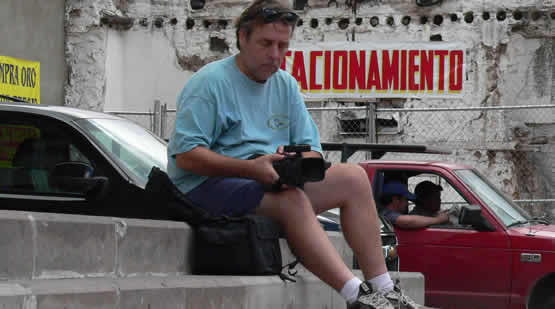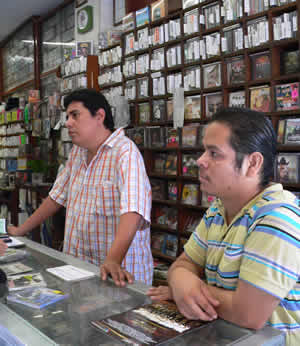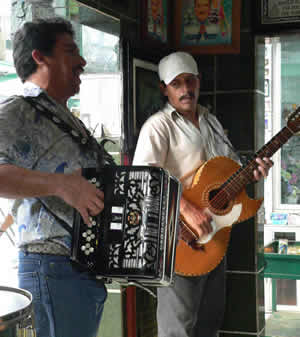Alumnus' documentary gives voice to poor
By Mary Frances Monckton Hendrix

Alumnus Donnie Meals sits on the steps of a government building in downtown Chihuahua, Mexico, in July 2007. His typical way of capturing footage was to use minimal equipment so that he wouldn’t attract attention to the camera.
There’s a legend from the early 1900s about a thief who stole from the rich to give to the poor. He was hunted by the law, but the poor people would hide him. He was wounded, and knowing he would die, told his friend to turn him in so the reward money could be used to feed the poor. He sounds a bit like Robin Hood, but he’s not. His name is Jesus Malverde, and his legend has been passed among generations through the corrido, a song that tells a story.

Daniel Jimenez (left) and his assistant run a music store in a market in Culiacan, Sinaloa, Mexico. Jimenez deals in popular music, especially narcocorrido CDs.
“El corrido is a form of music that’s been around for well over 100 years,” said Donnie Meals, a University of the Incarnate Word alumnus. It was Meals’ graduate thesis on the corrido that earned him recognition in December 2007 as an Outstanding Graduate Student for Research.
After two more years of research, film artist Meals has created a new documentary, “El Corrido: The Two Sides of the Song.” It was judged recently at the Accolade Film Awards competition in La Jolla, Calif., and awarded for Excellence in Film: Feature-length Documentary.
“In particular,” Meals said, “el corrido is a Mexican form of music that uses storytelling lyrics. Originally these were true stories – maybe about a lover, a horse or an event. As its popularity grew, it became a musical newspaper, sort of like in a troubadour style. They were a common person’s music.”
That would explain why the legend of Jesus Malverde and other unlikely heroes lives on.
“There’s nothing complicated about it. It’s just verse, verse, verse, verse. There would be one guy singing around a campfire, then two, then as musical influences changed, an accordion was added. The musical style is very straightforward,” he said. “Their popularity wasn’t because of the music but because they were good stories.”
Meals said he was attracted to learning more about the corrido because it is a musical style that doesn’t really exist in American culture.
“The closest thing here to el corrido would be Bob Dylan telling the story of the Hurricane (boxer Rubin Carter) or Gordon Lightfoot’s ‘The Wreck of the Edmund Fitzgerald.’ That’s not really the way songs go here. There are no repeating choruses like in popular music,” Meals said.
Another aspect of the corrido piqued Meals’ interest some 15 years ago when he worked in radio.
He said it was about that time that the Mexican government started banning corridos from being aired on the radio. The reason is because the songs were being adopted by the drug culture – the focus of the stories being told became about drug trafficking or shootings. Meals said such “narcocorridos” are often compared to American East Coast/West Coast rap.
“The very first popular narcocorrido came out in 1974,” Meals said.
“Corridos are fantasy stories, but then because one thing gets popular, others start to use it. Then the drug cartels realized they can use this to promote themselves over other cartels,” Meals said.
“I’m listening to this song, not really understanding the words, and it sounds really pretty,” he said. “But they’re singing about this guy’s gonna shoot his brother. The music has gotten pretty raw.”
Meals said his mission throughout the documentary process was to let the people tell the story. “I didn’t want to force my opinion on their culture,” he said.

Two musicians perform corridos in homage to Jesus Malverde, originally known as the "Generous Bandit" and the "Angel of the Poor." They perform inside the Capilla de Jesus Malverde (Chapel of Jesus Malverde), near downtown in Culiacan.
One interview was conducted while a taxi driver in Culiacan, Sinaloa, in northwestern Mexico, drove Meals to the Capilla (Chapel) de Jesus Malverde. “I just filmed him speaking in Spanish. Later, I started translating and he kept referring to ‘cuerno de chivo,’ which means ‘horn of a goat.’” Meals learned later that term was slang for a machine gun.
Meals said that although such narcocorridos have been banned from Mexican radio, one radio station in east Los Angeles still plays them. And classic corridos can be heard on the radio throughout Latin America.
Many people in the United States have heard a corrido without realizing it. Sung by mariachi musicians, “La Cucaracha” actually began as a corrido, Meals said.
“It was Pancho Villa’s marching song. Dozens, maybe hundreds of corridos were written about Villa and his escapades – always about his wins – as the one fighting for the poor people,” Meals said.
“One thing that was so enlightening to me – the whole idea behind corrido was a way to promote or talk about the rural people either to give them a hero to believe in or give them a sense of self,” Meals said. “The subjects were all people who were ignored by government, with a sense of the downtrodden, not being given an equal chance to live a prosperous life. Villa represented the poor.”
Vincent Rodriguez, assistant to the president/communications, who participated as a member of Meals’ thesis committee, praised his work.
“Donnie traveled a difficult and tricky road in earning his master’s degree," he said. "This was because of the subject matter he researched in his study – the transformation of the corridos into narcocorridos – and the format in which he presented his findings, which included a documentary DVD and a full written thesis.
“I’m proud of what Donnie accomplished in representing UIW and himself. He produced a fascinating study on a topic few of us know little about but whose ramifications loom large due to the glorification in some quarters in Mexico of the ongoing drug-related violence in that country.”
To hear a portion of the documentary, visit www.editpointstudios.com/elcorrido.
